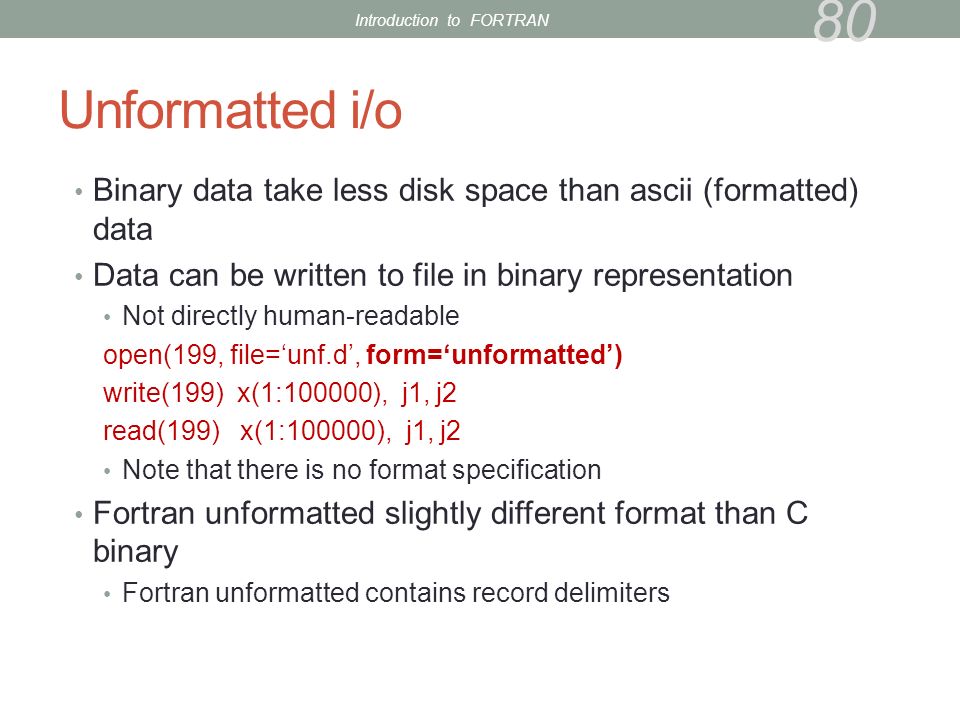Fortran Read Last Line From File


FORTRAN I/O FORTRAN: Input/Output (I/O) SIMPLE I/O: LIST-DIRECTED The simplest form of the I/O statement is the list-directed form which is represented by: READ(*,*) item1, item2, item3. WRITE(*,*) item1, item2, item3. Where ITEMx = a variable, a constant or math expression Example: WRITE(*,*) 'ALPHA=', ALPHA The first asterisk (*) means the input comes from the keyboard in a READ statement and goes to the screen in a WRITE statement. The second asterisk (*) means the computer decides how the I/O elements should look based on the TYPE of data in the input/output list.
This is sometimes called 'FREE-FORMAT'. NOTES ON LIST-DIRECTED I/O SPACES may be inserted between components of the statement to add clarity. The READ statement causes the program to PAUSE and allow you to enter values. The program will not continue until all values have been entered. Separate values with SPACES when typing data into the program with a READ operation. Make sure you press the ENTER key. Insert a WRITE statement to PROMPT yourself for input just before a READ statement.
This statement should tell the user WHAT to enter. GENERAL FORM OF I/O STATEMENTS The general form of the FORTRAN I/O statements allow data transfer to FILES, TAPE, PRINTER and other devices as well as the TERMINAL. Dying Light Patch 1.4 ^^nosteam^^.
I did some dummy code to learn to open and read file. Open and read data in one row in fortran 90. On the same line in the file the first read statement.
The general form is: WRITE(unit#, format, options) item1, item 2. READ(unit#, format, options) item1, item2. NOTE: We will restrict our use to TERMINAL and FILE I/O.
Typically, you transfer data files to/from tape, diskette, and printer by using UNIX (or DOS on PCs) commands, rather than a Fortran program reading or writing directly from/to the device. In this form, PARENTHESES are used to enclose information about the UNIT, the FORMAT (if any) and other options. Again, SPACES may be used to add clarity to the statement.
The input and output lists (item1, item2.) are composed of constants, variables or expressions, separated by COMMAS. UNIT NUMBER The UNIT is a number which has an association with a particular device. The device can be the TERMINAL or a FILE (or something else too). The UNIT is an INTEGER or INTEGER EXPRESSION, generally between 1-30.
Standard FORTRAN reserves two UNIT numbers for I/O to user. They are: UNIT = 5 for INPUT from the keyboard with the READ statement UNIT = 6 for OUTPUT to the screen with the WRITE statement Most versions of FORTRAN will also let you use the ASTERISK (*) for I/O to the TERMINAL. The asterisk can be used with both the READ and WRITE statements, thus there is no need to remember whether 5 or 6 is for input or output.
When I/O is to a file you must ASSOCIATE a UNIT number (which you choose) with the FILENAME. Use any unit number other than 5 and 6. On some computers, some unit numbers are reserved for use by the computer operating system. The association of the unit number and filename occurs when the OPEN statement is executed. Game Worms 2d For Pc on this page.
OPEN(UNIT=n, FILE='filename', options. Asasin Revolution Ckacat. ) This statement associates UNIT n with the file mentioned. All subsequent READs or WRITEs using unit n will be to or from this file. MISCELLANEOUS FILE I/O NOTES When doing I/O to a FILE, each READ statement inputs data from a NEW LINE and each WRITE statement outputs data on a NEW LINE. Most files are SEQUENTIALLY organized. You can't easily go back up in the file, but you can REWIND the file with: REWIND unit_number When you are finished with the file, you may CLOSE it with: close(10) or close(unit=10) (This is optional.) FORMAT IDENTIFIER The FORMAT IDENTIFIER as used in a WRITE or READ statement generally has one of two forms; • An asterisk (*), indicates LIST-DIRECTED or 'free format'. • A LABEL designates a FORMAT statement which specifies the format to use.